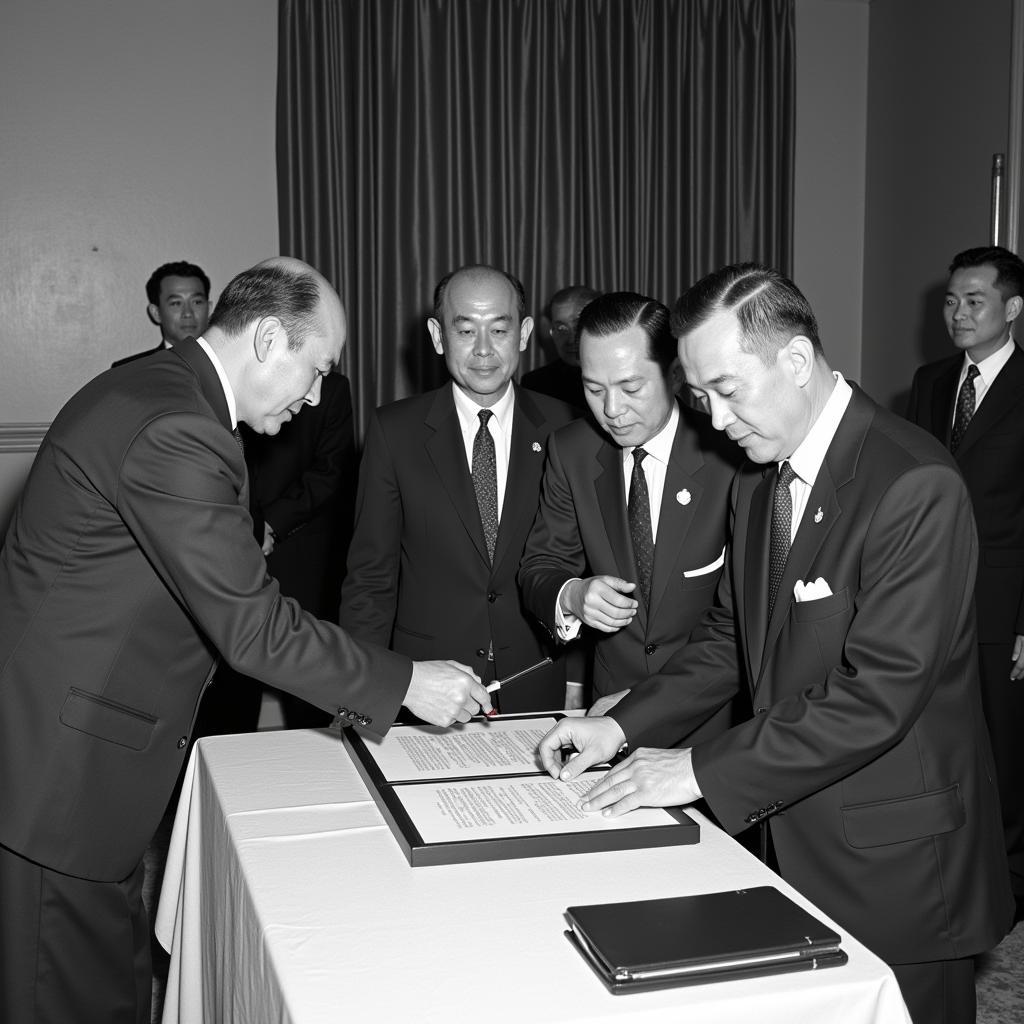The Association of Southeast Asian Nations (ASEAN) is a prominent intergovernmental organization that plays a crucial role in fostering political, economic, and socio-cultural cooperation in Southeast Asia. Understanding When Asean Was Formed is key to grasping its significance and evolution. This article explores the historical context surrounding ASEAN’s establishment, its founding members, and the key milestones that have shaped its journey. You can learn more about the reasons behind its formation by reading why ASEAN was formed.
The signing of the Bangkok Declaration on August 8, 1967, marked the official formation of ASEAN. This pivotal event laid the foundation for a regional organization dedicated to promoting peace, stability, and prosperity in Southeast Asia. The five founding members were Indonesia, Malaysia, the Philippines, Singapore, and Thailand. Their shared vision of a united and cooperative Southeast Asia paved the way for the organization’s development. Learn more about the reasons for the formation of ASEAN.
The Genesis of ASEAN: Post-Colonial Era and the Cold War
The years following World War II witnessed a wave of independence movements across Southeast Asia as nations broke free from colonial rule. This period of newfound sovereignty was, however, fraught with political instability, territorial disputes, and the looming threat of the Cold War. These challenges underscored the need for a regional mechanism to address shared concerns and foster cooperation among the newly independent states.
The Bangkok Declaration: A Cornerstone of Regional Cooperation
The Bangkok Declaration, also known as the ASEAN Declaration, outlined the fundamental principles and objectives of the organization. It emphasized respect for national sovereignty, territorial integrity, non-interference in internal affairs, and the peaceful settlement of disputes. The declaration also stressed the importance of economic, social, cultural, and technical cooperation among member states.
 ASEAN Founding Fathers Signing the Bangkok Declaration in 1967
ASEAN Founding Fathers Signing the Bangkok Declaration in 1967
Expanding Membership and Evolving Objectives
Over the decades, ASEAN has expanded its membership to include Brunei Darussalam, Cambodia, Laos, Myanmar, and Vietnam. This expansion reflects the organization’s growing influence and its commitment to inclusivity in Southeast Asia. ASEAN’s objectives have also evolved to encompass a wider range of issues, including environmental protection, disaster management, human rights, and counter-terrorism.
From Five to Ten: ASEAN’s Growth and Inclusivity
The inclusion of new members brought diverse perspectives and challenges. However, it also strengthened ASEAN’s collective voice and its ability to address regional issues effectively. The expansion of ASEAN demonstrates its adaptability and its ongoing commitment to fostering unity and cooperation within Southeast Asia.
ASEAN Today: A Driving Force in Regional Integration
Today, ASEAN plays a pivotal role in promoting regional integration and cooperation. It has established various mechanisms and frameworks to facilitate trade, investment, connectivity, and people-to-people exchanges. ASEAN also actively engages with its dialogue partners, including major powers like the United States, China, and Japan, to address global challenges and promote regional stability. Want to stay updated on ASEAN activities? Check out the ASEA newsletter.
Economic Integration and Beyond: ASEAN’s Multifaceted Approach
ASEAN’s focus on economic integration has led to the creation of the ASEAN Economic Community (AEC), which aims to create a single market and production base. Beyond economic cooperation, ASEAN also addresses critical issues like climate change, cybersecurity, and the promotion of sustainable development.
Conclusion: ASEAN’s Enduring Legacy
Since its formation in 1967, ASEAN has made significant strides in promoting peace, stability, and prosperity in Southeast Asia. When ASEAN was formed, it marked a turning point in the region’s history, laying the groundwork for a future of cooperation and integration. As ASEAN continues to evolve and adapt to new challenges, its enduring legacy lies in its ability to bring together diverse nations under a common banner of shared values and aspirations. You can delve deeper into the historical context of ASEAN’s formation by exploring when ASEAN was it formed.
FAQ
-
What does ASEAN stand for?
ASEAN stands for the Association of Southeast Asian Nations. -
When was ASEAN established?
ASEAN was established on August 8, 1967. -
Who are the founding members of ASEAN?
The founding members are Indonesia, Malaysia, the Philippines, Singapore, and Thailand. -
How many members does ASEAN have today?
ASEAN currently has ten member states. -
What is the purpose of ASEAN?
ASEAN aims to promote political, economic, and socio-cultural cooperation in Southeast Asia. -
Where is the ASEAN headquarters located?
The ASEAN Secretariat is located in Jakarta, Indonesia. -
How can I learn more about ASEAN’s history?
You can explore more resources online or visit the ASEAN Secretariat website.
Need further insights? Explore why is ASEAN formed.
Have you considered the benefits of an ASE Echo board? You can find helpful reviews at ASE echo board review videos.
When you need assistance, please contact us: Phone: 0369020373, Email: aseanmediadirectory@gmail.com. Our address is Thon Ngoc Lien, Hiep Hoa, Bac Giang, Vietnam. We have a 24/7 customer service team.

